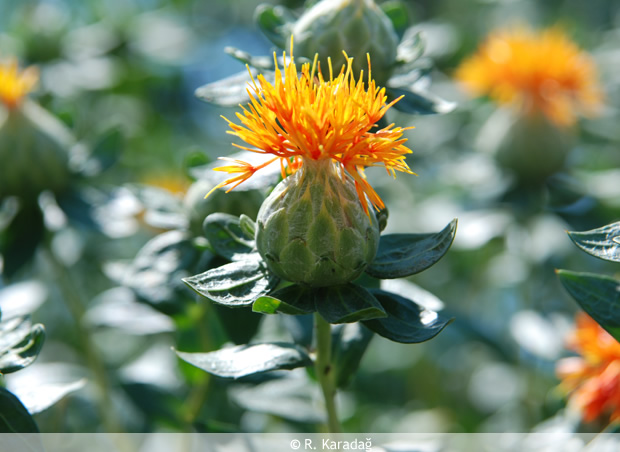Safflower is an annual thistle-like plant. It grows to almost 4 feet and has thorny, toothed leaves and large orange-yellow blossoms. Distribution: Safflower was probably originally endemic to Western Asia . It has been cultivated for thousands of years, not only in this area but also in North Africa and Europe . Material used for dyeing: Flowers.Historical Data
The florets of Safflower; have been used as a source of red dye for many centuries, mainly for silk, secondly for cotton. Safflower is a very ancient plant native to a large area from central Asia through Middle East to the Upper Nile River into Ethiopia . It has been cultivated around the Mediterranean for many centuries and has become naturalized there in many parts of south and central Europe and North Africa . The bright yellow linen mummy binding from the 12th Dynasty Tomb of the Two Brothers (about 2000B.C.) was analyzed and reported to have been dyed with safflower. Also it is mentioned that the Egyptian tombs dating back to other periods have contained linen clothes dyed with safflower. The florets contain a useless yellow colourant which is washed out with water. The red colourant carthamin remains. Safflower can yield a beautiful pinkish hue on a textile.The yellow and red petals of the flower can produce either colour depending on the dyeing process. Carthamin the red colouring substance is not soluble in water but dissolves in an alkaline aqueous solution, where safflower yellow is very soluble in even cold water. Mummies from Egyptian tombs have been found with bandages still dyed red with safflower and it is mentioned by Pliny in his Natural History. The yellow dye from safflower was long considered useless, whereas the red dye, safflower carmine, was highly valued, despite its poor lightfastness. Luxurious textiles contain safflower red, for example, the so-called Polish carpets from the 16th and 17th centuries. These famous silk carpets received their name in error at the World Exposition in Paris in 1878.They are not from Poland but rather from Persia , where they were made during the reign of Shah 'Abbas (1557- 1628). Many have survived to the present. Characteristic of them is that the red has faded entirely. Only deep in the knots can one get an idea of their once magnificent safflower red. In Ottoman court manufacture, safflower was apparently not used; at least none of Ottoman velvets and brocades has revealed carthamin according to the analyses made by R.Karadag and H. Bohmer. A valuable oil is pressed from the safflower seeds that has a high proportion of unsaturated fatty acids and is thus considered to be especially healthy. For this reason, cultivation has expanded in recent years. The dried flowers are sold in Mediterranean countries as false saffron and sometimes to tourists as true saffron.The red dye extracted from safflower was once widely used in the East for manufacture of lakes and cosmetics. Safflower was the dye used to bind legal documents the pinkish red of red tape . It is still used in manufacture of rouge and lipsticks. It is also used for colouring liquors. Safflower was used to produce the red pigment extracted with soda, precipitated with citric acid, then slowly dried in the shade before being ground into a powder with talc. The pigment was then sold, which was a much safer product than the metallic rouges based on lead which were formerly used.

